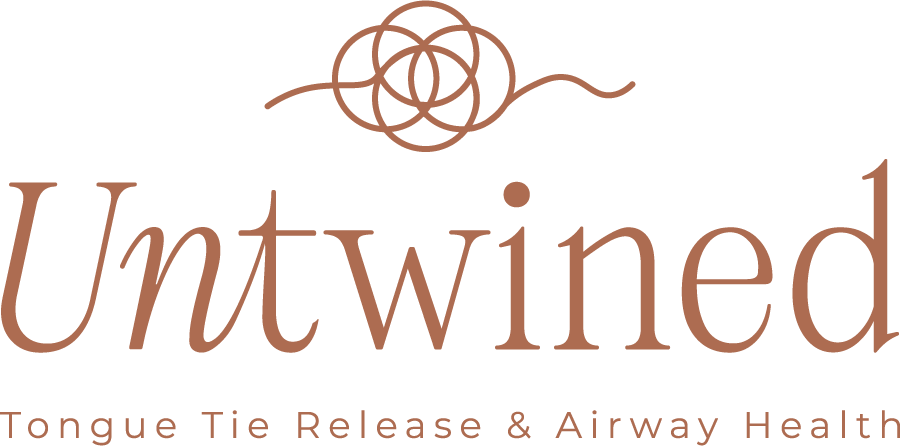Our Service Offerings
Discover the cutting-edge care we offer for tongue and lip tie releases using our advanced CO2 laser technology. Our procedures are quick, minimally invasive, and designed to minimize discomfort and promote rapid recovery. We also provide essential post-procedure care for infants and integrate personalized myofunctional therapy for older children and adults to ensure optimal outcomes and improved overall health.
Our Specialties
-
Myofunctional Therapy:
Myofunctional therapy is a series of exercises designed to restore proper breathing and oral function. This is achieved by strengthening the muscles of the tongue, lips, face and neck, much like physical therapy does for the rest of the body. It is most often necessary for children and adults before a tongue tie is released to prepare the tongue and train it afterwards.
-
Infant, Child and Adult Tongue Tie Release:
At Untwined, we perform all tongue and lip tie releases using a CO2-laser. A CO2 laser is quick and precise, allowing for shorter operative time and reduced bleeding. This helps reduce pain from the procedure, infection risk, and swelling. The procedure takes a matter of minutes on an infant and we provide parents with instructions on stretches to achieve the best outcomes for their baby after the procedure. For Children and Adults, the procedure is most often coupled with myofunctional therapy before and after the release.
At our practice, we prioritize individualized care and an integrative approach, recognizing the interconnectedness of oral health, airway function, and overall well being. Our mission is to empower our patients to thrive by addressing their unique needs and supporting them every step of the way.
Allow us to join your family on a journey to health and happiness.
FAQs
-
A tongue-tie is an abnormality in connective tissue at the bottom of the tongue. In 5-10% of children this tissue does not lengthen or narrow properly while developing in the uterus. This limits the normal motion of the tongue. Because the tongue is so critical to feeding, speech, breathing, and proper oral development and function, a restriction in its motion has major impacts on infant development. Tongue tie symptoms can include difficulty with breastfeeding, abdominal discomfort from excess ingestion of air, trouble with speech development, and abnormal breathing patterns. Similar thickening or shortening of connective tissue can happen in the upper lip (lip-tie) or the sides of the mouth (cheek/buccal-tie), and both can cause similar developmental problems.
-
An expert evaluation of oral anatomy and function can determine if a tongue, lip, or cheek-tie requires treatment. These oral tissue abnormalities do not always require a release and it is important to first exclude other potential causes of symptoms (i.e. nasal or airway obstruction, acid reflux, etc.). Dr. Nadine will guide the patient and families through an in-depth discussion exploring symptoms, potential causes, and treatment options. After a thorough interview, if an oral tissue abnormality is determined to be the cause of infant feeding difficulties, then an oral tie release is recommended. The same principle that emphasizes oral function applies to older ages. If an older child or adult has difficulties with speech or breathing patterns, for example, then treatment may be recommended in conjunction with pre and post release therapies.
-
Through myofunctional therapy we help our patients achieve better sleep, effective breathing, reduced jaw pain, and enhanced outcomes from tongue tie release, orthodontics and cpap usage.
Myofunctional therapy focuses on improving function in four areas. Nasal breathing, proper tongue posture, lip seal, and proper swallowing pattern. By restoring these basic functions through specially tailored therapy programs, our patients can see lifelong improvements in their overall health.
-
The first step at Untwined is a thorough discussion with Dr. Nadine regarding tongue function, oral symptoms, and causes of these symptoms. Based on this discussion, a referral to a feeding specialist, lactation consultant, chiropractor, craniosacral therapist or myofunctional therapist may be recommended before and/or after a tongue-tie release for an infant. The goal of this detailed evaluation is to prevent an unnecessary or premature procedure. Moreover, our multidisciplinary approach helps to optimize the patient’s oral function to achieve the best potential/possible outcome. It is important to us that the families we treat always feel supported by us no matter what treatment pathway they choose.
-
Untwined provides out-of-network care for all medical and dental insurance. We are a fee-for-service practice. This allows us to provide the best personalized care for our patients without restrictions imposed by insurance companies, along with the opportunity to spend ample time with our patients without limitation. At the end of the treatment plan, we provide documentation called a super-bill that may be reimbursed in part by your insurance. We recommend that patients check with their insurance providers ahead of time to learn how much insurance may provide reimbursement.
Additional Resources for patients and families
Access a wealth of information on tongue ties, oral health, and multidisciplinary care approaches from leading experts and publications.
-
Society Guidelines: The American Academy of Pediatric Dentistry provides an excellent summary of the recent data regarding tongue-tie symptoms, reasons to treat, the importance of a multidisciplinary approach, and treatment options. These help inform our treatment approach and can be found here: Policy on management of the frenulum in pediatric patients. The Reference Manual of Pediatric Dentistry. 2023.
-
The following summaries of research articles have been complied by experts in the oral-tie research field: Dr. Chesea Pinto DDS & Dr. Lawrence Kotlow DDS.
-
The following oral-tie and oral health books provide additional insight:
Tongue Tied by Dr. Richard Baxter
Sleep Wrecked Kids by Sharon Moore
Breath by James Nestor


